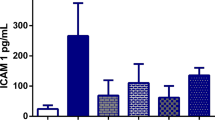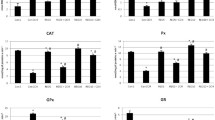Abstract
The efficacy of Withania somnifera (Ws) to limit myocardial injury after ischemia and reperfusion was explored and compared to that of Vit E, a reference standard known to reduce mortality and infarct size due to myocardial infarction. Wistar rats (150–200 g) were divided into six groups and received orally saline (sham, control group), Ws-50/kg (Ws control and treated group) and Vit E-100 mg/kg (Vit E control and treated group) respectively for 1 month. On the 31st day, rats of the control, Vit E and Ws treated groups were anesthetized and subjected to 45 min occlusion of the LAD coronary artery followed by 60 min reperfusion. Hemodynamic parameters: systolic, diastolic and mean arterial pressure (SAP, DAP, MAP), heart rate (HR), left ventricular end diastolic pressure (LVEDP), left ventricular peak (+) LVdP/dt and (−) LVdP/dt were monitored. Hearts were removed and processed for histopathological and biochemical studies: Myocardial enzyme viz, creatin phosphokinase (CPK), and antioxidant parameters: malondialdehyde (MDA), glutathione (GSH), superoxide dismutase (SOD), catalase (CAT), glutathione peroxidase (GSHPx) were estimated. Postischemic reperfusion produced significant cardiac necrosis, depression of left ventricular functions (MAP, LVEDP, (+) and (−) LVdP/dt) and a significant fall in GSH (p < 0.01), SOD, CAT(p < 0.05), LDH and CPK (p < 0.01) as well as an increase in MDA level (p < 0.05) in the control group rats as compared to sham group. The changes in levels of protein and GPx was however, not significant. Ws and Vit E favorably modulated most of the hemodynamic, biochemical and histopathological parameters though no significant restoration in GSH, MAP (with Vit E) were observed. Ws on chronic administration markedly augmented antioxidants (GSH, GSHPx, SOD, CAT) while Vit E did not stimulate the synthesis of endogenous antioxidants compared to sham. Results indicate that Ws significantly reduced myocardial injury and emphasize the beneficial action of Ws as a cardioprotective agent.
Similar content being viewed by others
References
Maxwell RJS: Reperfusion injury: A review of the pathophysiology, clinical manifestations and therapeutic options. Int J Cardiol 58: 95-117, 1997
Burton KP, McCord JM, Ghai G: Myocardial alteration due to free radical generation. Am J Physiol 84: H776-H783, 1984
Downye JM: Free radicals and their involvement during long term myocardial ischemia and reperfusion. Ann Env Physiol 52: 487-507, 1990
Hertog MGL, Feskens EJM, Hollam PCH, Katan MB, Kromhout D: Dietary antioxidant flavonoids and risk of coronary heart diseases. The Zutphen Elderly Study. Lancet 342: 1007-1020, 1993
Lavie D, Glotter E, Shro Y: Constituents of Withania somnifera. Dun IV J Chem Soc 7517, 1965
Malhotra CL, Prasad KS, Das PK, Dhalla NS: Studies on Withania somnifera (Part III). The effect of total alkaloid (Ashwagandholine) on CVS and respiration. Ind J Med Res 49: 449, 1961
Dhuley JN: Adaptogenic and cardioprotective action of ashwagandha on rats and frogs. J Ethnopharmacol 70: 57-63, 2000
Spencer AP, Carson DS, Crouch MA: Vitamin E and coronary artery disease. Arch Intern Med 159: 1313-1320, 1999
Ohkawa H, Ohishi N, Yagi K: Assay of lipid peroxide in animal tissue by thiobarbituric acid reaction. Anal Biochem 95: 351-358, 1979
Caband PG, Wroblewski F: Colorimetric measurements of lactic dehydrogenase activity of body fluids. Am J Clin Path 234-236, 1958
Moron MS, Depierre JW, Manmerik B: Level of glutathione, glutathione reductase and glutathione-s-transferase activity in rat lung and liver. Biochemical Biophysica Acta 82: 67-78, 1979
Paglia DE, Valentine WN: Studies on the quantitative and qualitative characterization of erythrocyte peroxidase. J Lab Clin Med 2: 158, 1967
Mishra HP, Fridovich I: The oxidation of phenylhydrazine: Superoxide and mechanisms. Biochemistry 15: 681-687, 1976
Aebi H: Catalase. In: H.E. Bergmayer (ed). Methods of Enzymatic Analysis, Ed. II, Vol. 2. Academic Press, New York, 1974
Lowry OH, Rosebrough NJ, Farr AI: Protein measurements with the Folin phenol reagent. J Biol Chem 193: 265-275, 1951
Lamprecht W, Stan F, Weisser H, Heinz F: Determination of creatine phosphate and adenosine triphosphate with creatine kinase. In: H.U. Bergmeyer (ed). Methods of Enzymatic Analysis. Academic Press, New York, 1974, pp 1776-1778
Baxter GF: The neutrophil as a mediator of myocardial ischemia-reperfusion injury: Time to move on. Basic Res Cardiol 97: 268-275, 2002
Kaul N, Siveski LH, Hill M, Slezak J, Singal PK: Free radicals and the heart. J Pharmacol Toxicol Methodol 20: 55-57, 1993
Dhalla NS, Elmoselhi AB, Hata T, Makino N: Status of myocardial antioxidants in ischemia-reperfusion injury. Cardiovasc Res 47: 446-456, 2000
Freeman B, Crapo J: Biology of disease: Free radicals and tissue injury. Lab Invest 47: 412-426, 1982
Jennings RB, Murry CE, Steenbergen CJR, Reimer KA: Acute myocardial ischemia: Development of cell injury in sustained ischemia. Circulation 82: 3-12, 1990
Dormandy TL: Free radical oxidation and antioxidants. Lancet 1: 647-650, 1978
Lei XL, Chiou GC: Cardiovascular pharmacology of Panax noto ginseng (Bark) FH Chen and Salvia miltiorrhiza. Am J China Med 14: 145-152, 1986
Devi PU, Ganasoundari A: Modulation of glutathione and antioxidant enzymes by Ocimum sanctum and its role in protection against radiation injury. Indian J Exp Biol 37: 162-168, 1999
Bhattacharya SK, Satyan KS, Ghosal S: Antioxidant activity of Bacopa monniera in rat frontal cortex, straitum and hippocampus. Phytother Res 14: 174-179, 2000
Author information
Authors and Affiliations
Rights and permissions
About this article
Cite this article
Mohanty, I., Gupta, S.K., Talwar, K.K. et al. Cardioprotection from ischemia and reperfusion injury by Withania somnifera: A hemodynamic, biochemical and histopathological assessment. Mol Cell Biochem 260, 39–47 (2004). https://doi.org/10.1023/B:MCBI.0000026051.16803.03
Issue Date:
DOI: https://doi.org/10.1023/B:MCBI.0000026051.16803.03




